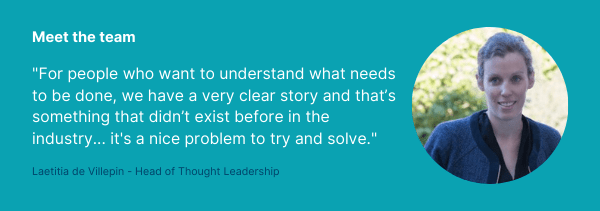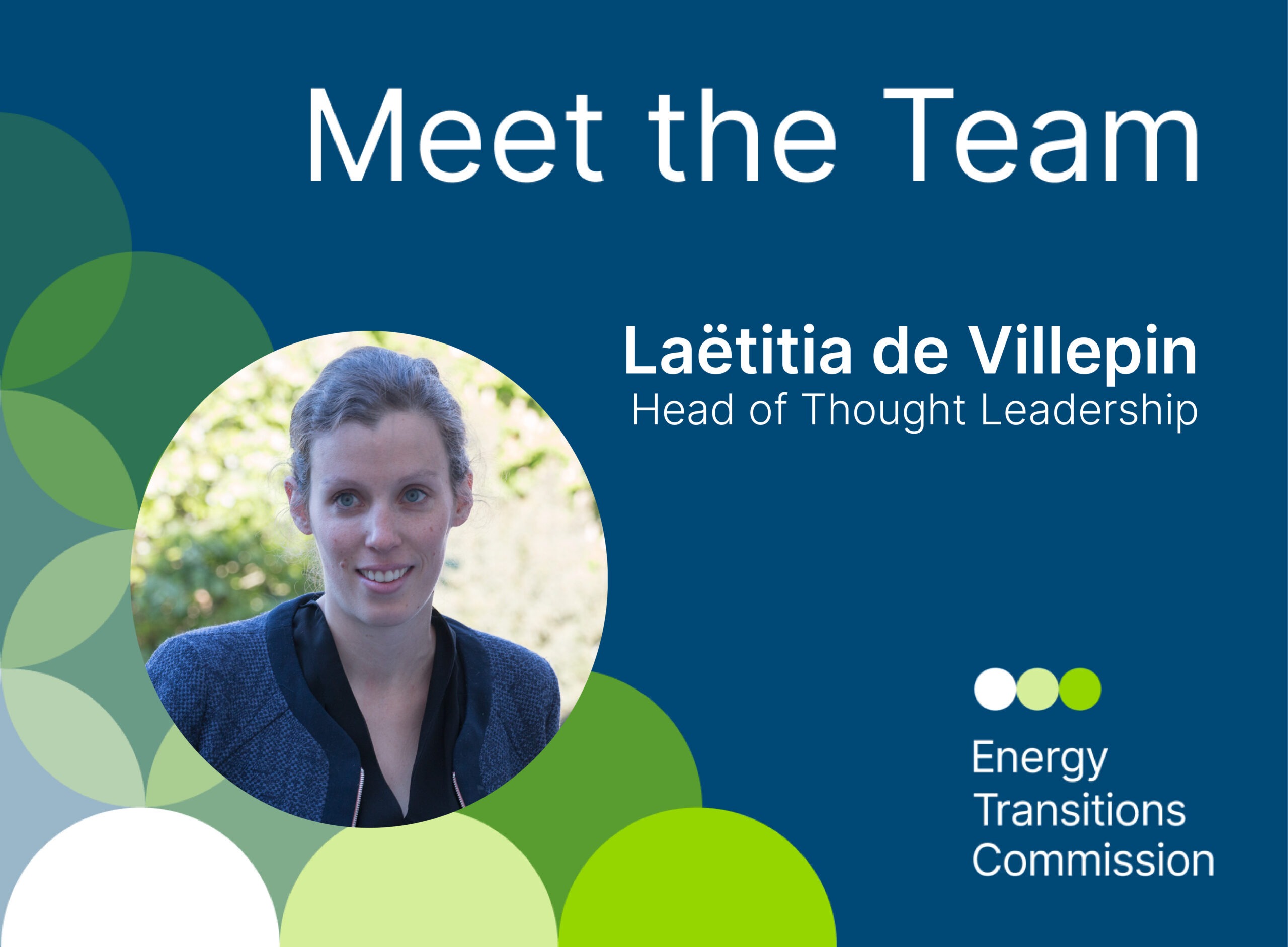Get to know us! Each issue we sit down with a core team member and chat about their work and objectives; their views on mitigating climate change, and their inside perspectives on the ETC’s workstreams and analysis.
Today we sit down to talk with Laëtitia de Villepin, our Head of Thought Leadership, a ‘veteran’ of the ETC and architect of our landmark report, Making Mission Possible.

- What made you join the ETC?
I joined three and a half years ago, previously being a consultant at McKinsey. I joined the ETC – and SYSTEMIQ – because I wanted to focus on energy topics. I was particularly interested in energy matters because it’s super exciting to work on a subject that is extremely technical – so you feel that increasing your knowledge increases your intelligence in tackling the challenges – and it’s also a dynamic substance, so there is innovation all the time. Additionally it’s extremely political. It touches upon societal choices; it affects the lives of individuals, or our standard of living. I like that it’s both very complex, but that you can understand the different dimensions; the necessary compromises. It’s a nice problem to try and solve.
- What is your most proud achievement at the ETC?
I would have to say two things. The first is on output: the Making Mission Possible integrated story – which very much builds on the Mission Possible story. Seeing the escalation in the story here makes me very proud – to see that we have managed to put together something that is a complete vision of what needs to happen in the energy sector by 2050. I think we have shaped the debate, we have influenced the discussion and the agenda in both the energy and the sustainability space. We have created a few concepts and ideas that are now mainstream, such as the ‘harder-to-abate sectors’ – or even fuelled some already existing ones like ‘net-zero requirements’. In the end, for people who want to understand what needs to be done, we have a very clear story and that’s something that didn’t exist before in the industry.
The second achievement would relate to growing the team, both internally and externally (members). At first the ETC was very much a ‘club of the happy few’ and now it’s a lot more inclusive. We are in collaboration with a lot of great institutions, exciting individuals, and companies. I am very proud we have found this space in the wider ecosystem and created these friendships that help change the system. And internally it’s lovely to be developing such a great team that works together to support this journey.
- What does the energy transition mean to you?
To me it’s about reaching a target. And the target is to be on the 1.5 degree trajectory (or below). To get there the UN’s Intergovernmental Panel on Climate Change (IPCC) tells us we need to be net-zero by 2050 – and we need to start decarbonizing NOW to be on this steep trajectory to get there. The ETC has a three step framework, a sort of action-guide of what we need to do to get there. The first step, often overlooked by the industry, is to use less energy. Using less energy means being more efficient in the way we use energy, but also more efficient in the way we use materials; through circularity, waste reduction, or light-weighting. it means changing the business model – the way we consume – changing our behaviour patterns to be more efficient, for example through the sharing economy. At the ETC we insist on this first step a lot; we need to achieve the same standards of living with less energy and materials. Once you have reduced the size of the challenge by decreasing energy usage, the second step is to scale up the clean energy generation. If you want a clean system, you need access to clean energy. That means multiplying by 10 to 15 times your clean electricity generation, through variable renewables for example. But also using indirect electricity uses, like hydrogen or ammonia (fuels produced through electricity). And then you can also use alternative decarbonization sources, like ramping up the generation of bioenergy sources. So the second step is making clean energy available, and the final step is to really clean up the uses; decarbonize the supply side. That is primarily achieved by electrifying everything that you can electrify – because it’s the most efficient source of energy. Then using either electricity-based-fuels (see step 2) or bioenergy, or finally, Carbon Capture & Storage (CCS) when you have no other choice than to use fossil fuels.
- What do you feel is the biggest obstacle to net-zero?
Political inertia seems to be the stumbling block. Very often, the ETC’s analytical conclusion is that if we want something to scale-up – whether it’s technology or behavioural change – in the beginning, the first spark must come from an external political willingness. And then the market and people’s actions will follow. Too often we know what needs to be done, but there is a lot of inertia because we are protecting ‘the way things are’ – we see change as risky. It’s a question of political willingness, and if we want to make it easier for policymakers to be ambitious and radical in their policies – we need to align the necessary changes across the planet. Global alignment means change becomes mainstream, rather than waiting for one person to be the leader for change.
- What are you most excited about that’s coming up at the ETC?
We have just come out with our latest Power and Hydrogen reports, which are historically two topics of expertise for the ETC. We feel confident about the messages in these spaces. I am now working on the Bioeconomy report, which is our third analytical workstream for 2021 – and we are coming at it from a different angle. There are a lot of uncertainties, a lot of debate around the topic – within the ETC, within members, and in the outside world. This is simply because nature is a very complex topic. It is more complex to frame than other workstreams. We have to articulate the concept of supply and demand, we need to understand what sustainability means on a more complicated level. This is why I am excited that we are publishing the bioeconomy report at the end of June. It’s dangerous waters to navigate, but we are trying to go the ETC way – which is to provide leads and suggestions that will be able to frame the debate and shape the ambition. We are trying to be very ambitious, because if you over-reach your biomass budget in order to decarbonize, you actually put the ecosystem in danger – putting the 1.5 degree trajectory in danger. It could also be a cautionary tale and we are very much working on a nuanced and balanced message to clarify what the challenges are.
- What is the best piece of advice you have received from an ETC colleague?
“Our role is to lead, not follow: don’t hesitate to be radical in the change you advocate for, as the industry and governments are catching up fast.”



